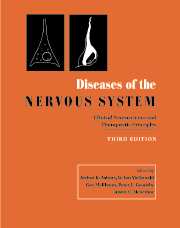Book contents
- Frontmatter
- Dedication
- Contents
- List of contributors
- Editor's preface
- PART I INTRODUCTION AND GENERAL PRINCIPLES
- PART II DISORDERS OF HIGHER FUNCTION
- 13 Congenital disorders of cerebral cortical development
- 14 The aging brain: morphology, imaging and function
- 15 Neurodegenerative diseases
- 16 Aging and dementia: principles, evaluation and diagnosis
- 17 Alzheimer's Disease
- 18 Dementia with Lewy bodies
- 19 Frontotemporal dementia
- 20 Consciousness and its disorders
- 21 Mechanisms of memory and amnestic syndromes
- 22 Acquired disorders of language
- 23 Neglect
- 24 Brain death
- 25 Disorders of mood
- 26 Schizophrenia
- 27 Obsessive–compulsive disorder
- 28 Autism and autistic spectrum disorders
- 29 Attention deficit hyperactivity disorder: spectrum and mechanisms
- 30 The neurobiology of drug addition
- PART III DISORDERS OF MOTOR CONTROL
- PART IV DISORDERS OF THE SPECIAL SENSES
- PART V DISORDERS OF SPINE AND SPINAL CORD
- PART VI DISORDERS OF BODY FUNCTION
- PART VII HEADACHE AND PAIN
- PART VIII NEUROMUSCULAR DISORDERS
- PART IX EPILEPSY
- PART X CEREBROVASCULAR DISORDERS
- PART XI NEOPLASTIC DISORDERS
- PART XII AUTOIMMUNE DISORDERS
- PART XIII DISORDERS OF MYELIN
- PART XIV INFECTIONS
- PART XV TRAUMA AND TOXIC DISORDERS
- PART XVI DEGENERATIVE DISORDERS
- PART XVII NEUROLOGICAL MANIFESTATIONS OF SYSTEMIC CONDITIONS
- Complete two-volume index
- Plate Section
14 - The aging brain: morphology, imaging and function
from PART II - DISORDERS OF HIGHER FUNCTION
Published online by Cambridge University Press: 05 August 2016
- Frontmatter
- Dedication
- Contents
- List of contributors
- Editor's preface
- PART I INTRODUCTION AND GENERAL PRINCIPLES
- PART II DISORDERS OF HIGHER FUNCTION
- 13 Congenital disorders of cerebral cortical development
- 14 The aging brain: morphology, imaging and function
- 15 Neurodegenerative diseases
- 16 Aging and dementia: principles, evaluation and diagnosis
- 17 Alzheimer's Disease
- 18 Dementia with Lewy bodies
- 19 Frontotemporal dementia
- 20 Consciousness and its disorders
- 21 Mechanisms of memory and amnestic syndromes
- 22 Acquired disorders of language
- 23 Neglect
- 24 Brain death
- 25 Disorders of mood
- 26 Schizophrenia
- 27 Obsessive–compulsive disorder
- 28 Autism and autistic spectrum disorders
- 29 Attention deficit hyperactivity disorder: spectrum and mechanisms
- 30 The neurobiology of drug addition
- PART III DISORDERS OF MOTOR CONTROL
- PART IV DISORDERS OF THE SPECIAL SENSES
- PART V DISORDERS OF SPINE AND SPINAL CORD
- PART VI DISORDERS OF BODY FUNCTION
- PART VII HEADACHE AND PAIN
- PART VIII NEUROMUSCULAR DISORDERS
- PART IX EPILEPSY
- PART X CEREBROVASCULAR DISORDERS
- PART XI NEOPLASTIC DISORDERS
- PART XII AUTOIMMUNE DISORDERS
- PART XIII DISORDERS OF MYELIN
- PART XIV INFECTIONS
- PART XV TRAUMA AND TOXIC DISORDERS
- PART XVI DEGENERATIVE DISORDERS
- PART XVII NEUROLOGICAL MANIFESTATIONS OF SYSTEMIC CONDITIONS
- Complete two-volume index
- Plate Section
Summary
Not too many years ago, the concept by both physicians and the general public was that your brain deteriorated as you got older. It was believed that, with aging, the brain shrank, there was significant drop out of nerve cells throughout the brain, and that once lost, those cells could not be replaced. In addition, at a subcellular level, data suggested that synaptic contacts markedly decreased. Moreover, it was thought that these changes began among individuals in young adulthood and progressed inexorably across the adult life span. As we will emphasize, among individuals who are optimally healthy these previously held concepts are wrong. The information that allows us to draw this conclusion is based on modern technologies for studying postmortem tissue, imaging the living brain, careful cognitive evaluations, and the innovative use of animal models.
Methodologic and technical issues
Focus on optimally healthy older individuals
One of the major changes to occur in the study of brain–behaviour relationships in aging is the focus on optimally healthy participants. This permits one to differentiate changes related to disease from those related to age. Among human subjects, this requires careful exclusion of subjects in the early stages of dementia. However, many medical diseases are common in older individuals (e.g. hypertension, respiratory or cardiac disease, vitamin deficiency), all of which may impair intellectual function. Ideally, if one wants to study healthy individuals, these disorders should be excluded as well. Subjects selected without evidence of clinical disease will differ greatly from a group of older persons that is chosen at random from a population, containing many individuals with serious medical illness. Some of these illnesses will include those with considerable impact on cognitive function, such as Alzheimer's disease (Odenheimer et al., 1994). Thus, optimally healthy individuals, although non-representative, can be of heuristic value, and may ultimately make it easier to identify interventions that can minimize age-related cognitive change.
Inter-individual differences and aging
In recent years, when researchers have focused their attention on animal models and human studies of aging, it has become clear that, even among optimally healthy subjects, there is considerable variability in both cognitive and physical abilities.
- Type
- Chapter
- Information
- Diseases of the Nervous SystemClinical Neuroscience and Therapeutic Principles, pp. 195 - 209Publisher: Cambridge University PressPrint publication year: 2002

